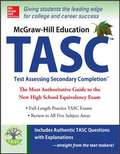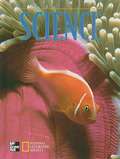- Table View
- List View
McGraw Hill Ciencias (Grade #1)
by Lucy Daniel Joanne Vasquez Jay Hackett Richard Moyer Prentice Baptiste Pamele StrykerSpanish text book Science
McGraw Hill Science (Grade 1, Tennessee Edition)
by Richard H. Moyer Joanne Vasquez Jay Hackett Pamela Stryker Prentice Baptiste Lucy H. DanielThis book covers science in three units: life science, earth science and physical science.
McGraw Hill Science (Tennessee Edition)
by Richard H. Moyer Jay Hackett Lucy H. Daniel H. Prentice Baptiste [et al.]An edition that instills scientific knowledge on its readers in an interesting yet knowledgeable way; you will learn many new words that means new ideas with image descriptions that will help you understand what you are reading.
McGraw Hill Science 3rd Grade
by Lucy Daniel Joanne Vasquez Jay Hackett Richard Moyer Pamela Stryker H. Prentice BaptisteGeneral science textbook.
McGraw Hill Science, Grade 4
by National Geographic Society Macmillan Mcgraw-HillThis grade4 science covers lessons on 1. Life Science: The World of Living Things; Animals as Living Things, 2.Earth Science: Earth and Beyond; Water and Weather, 3.Physical Science: Matter; and Energy.
McGraw Hill Science: Grade 2
by Mcgraw HillThe three major topics covered in this book are Life, Earth and Physical Science.
McGraw- Hill Science
by Lucy Daniel Joanne Vasquez Jay Hackett Richard Moyer Pamela Stryker H. Prentice BaptisteLearn more about what scientists do, and how you can explore the world through science yourself!
McGraw-Hill Ciencias (Grade 2, Edicion para Texas)
by Lucy Daniel Joanne Vasquez Jay Hackett Richard Moyer Pamela Stryker Prentice BabtisteA Spanish Science textbook.
McGraw-Hill Ciencias (Grade 4, Edicion para Texas)
by Lucy Daniel Joanne Vasquez Jay Hackett Richard Moyer Pamela Stryker Prentice BabtisteSpanish science textbook.
McGraw-Hill Education TASC - Test Accessing Secondary Completion
by Kathy A. ZahlerIt's packed with everything you need to succeed on the test---and get the high school credential you want. Only this guide can show you exactly what to expect on the test, tell you how the test is scored, and give you authentic TASC questions for practice. That makes this bestselling guide your most reliable and accurate source for everything you need to know about the TASC.
McGraw-Hill Science
by Richard H. Moyer Joanne Vasquez Jay Hackett Pamela Stryker H. Prentice Baptiste Lucy H. DanielTopics broadly covered in this book are life science, earth science, physical science motion, work, and machines.
McGraw-Hill Science
by Richard H. Moyer Joanne Vasquez Jay Hackett National Geographic Society Pamela Stryker H. Prentice Baptiste Lucy H. DanielThis book is organized into four units-Life, Physical, Earth, and Human Body sciences.
McGraw-Hill Science (Grade #3)
by Mcgraw-Hill Science StaffA living thing grows. It starts out small. Then it gets bigger. An oak tree begins as an acorn. Then it grows to become a green sapling. This is a very young tree. Organisms also change as they grow. The way a living thing changes during its life is called development.
McGraw-Hill Science (Grade 2, Tennessee Edition)
by Lucy Daniel Joanne Vasquez Jay Hackett Richard Moyer Pamela Stryker Prentice BaptisteScience textbook for 2nd graders in Tennessee.
McGraw-Hill Science (Grade 2, Texas Edition)
by Richard H. Moyer Joanne Vasquez Jay Hackett Pamela Stryker H. Prentice Baptiste Lucy H. DanielThe Texas edition of this science text book for Grade 2 contains unit lessons on Watering Earth Planets, Clues from the past, Changes all around, Watch it move, Rocky Homes, Human Body: Heart and Lungs, and also Your Text Book at a Glance, National Geographic invitation to Science, Be a Scientist and Texas Topics.
McGraw-Hill Science (Grade 5, Texas edition)
by Lucy Daniel Joanne Vasquez Jay Hackett Richard Moyer Pamela Stryker Prentice BaptisteScientists are curious about the world around them. This curiosity causes them to ask questions about things they don't understand. Sometimes they question the explanations accepted by others.
McGraw-Hill Science 1st Grade (California Edition)
by McGraw-HillScientific progress is made by asking meaningful questions and conducting careful investigations. As a basis for understanding this concept and addressing the content in the other three strands, students should develop their own questions and perform investigations.
McGraw-Hill Science 5th Grade: Tennessee Edition
by Richard Moyer Mcgraw-Hill StaffA general science book for fifth grade students.
McGraw-Hill Science 6th Grade, Unit B: Organization of Living Things
by Lucy Daniel Joanne Vasquez Jay Hackett Richard Moyer Pamela Stryker H. Prentice BaptisteThis book deals with lessons on Cells and Inheriting Traits.
McGraw-Hill Science Unit B: Interactions of Living Things
by Richard H. Moyer Jay Hackett Pamela Stryker H. Prentice Baptiste Lucy H. Daniel Jo Anne VasquezUnit B of McGraw-Hill Science.
McGraw-Hill Science Unit F: Motion and Energy
by Richard H. Moyer Joanne Vasquez Jay Hackett Pamela Stryker H. Prentice Baptiste Lucy H. DanielThis Unit F on Physical Science--Motion and Energy-- contains Newton's Laws of Motion, Sound Energy and Light Energy.
McGraw-Hill Science: Grade 5 Science
by Mcgraw-Hill Science StaffTim Laman's research takes him up into the sky-high rain forest canopy of Indonesia's Gunung Palung National Park. The Harvard University biologist climbs trees in the rain forest to study strangler figs. The figs sprout high in the trees and send their roots snaking down to the ground. Eventually the roots circle the host tree, cutting off growth.
McGraw-Hill Science: Observing The Sky 6th Grade
by Lucy Daniel Joanne Vasquez Richard Moyer Pamela Stryker Jay Hackett H. Prentice BaptisteThe branch of science that deals with "what's up there" is astronomy. Astronomy is the study of the universe. The universe is everything that exists--Earth and all the things in space. The contents of space include the planets, stars, and galaxies.


